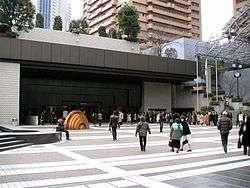Suntory Hall
| Suntory Hall サントリーホール | |
|---|---|
 | |
| General information | |
| Address | 1-13-1 Akasaka |
| Town or city | Minato, Tokyo |
| Country | Japan |
| Coordinates | 35°39′59.9″N 139°44′29″E / 35.666639°N 139.74139°ECoordinates: 35°39′59.9″N 139°44′29″E / 35.666639°N 139.74139°E |
| Opened | 1986 |
| Cost | ¥ 6,000 million |
| Owner | Suntory |
| Technical details | |
| Floor area | 12,027 m2 |
| Design and construction | |
| Architect | Yasui Architects |
| Other designers | Nagata Acoustics |
| Website | |
| Homepage | |
| References | |
| Factsheet | |
The Suntory Hall (サントリーホール) is a concert hall complex consisting of the "Main Hall" and the "Small Hall" located in the Ark Hills complex, near the U.S. Embassy and TV Asahi in the Akasaka district of northern Minato, Tokyo, Japan. Construction started in the late 1970s and it opened in October 1986. Herbert von Karajan described the hall as "a jewel box of sound".[1]
History
The Suntory Hall opened on 12 October 1986 in commemoration of the sixtieth anniversary of whisky production and twentieth of that of beer by Suntory.[2]
The Herbert von Karajan plaza in front of the Suntory Hall, which was constructed in April 1998, is in remembrance of the maestro, who was involved in the design of the hall[3] and who also recommended its vineyard style[1] as used at the Berliner Philharmonie, in which the audience surrounds the concert floor in the Main Hall. He also helped with its acoustical evaluation. Architectural design was by Shoichi Sano, Yasui Architects and that of the acoustics by Nagata Acoustics and its director Yasuhisa Toyota.[2][4]
The Suntory Hall has had performers and conductors from all around the world, including Karajan, Leonard Bernstein, Seiji Ozawa, Giuseppe Sinopoli, Claudio Abbado, Wolfgang Sawallisch, Hiroshi Wakasugi, Mitsuko Uchida, and Hermann Prey.[5]
Performance and other facilities
Main Hall
The seats in the Main Hall are situated around the concert stage (250 m2 in 27 sections), with a capacity of 2,006 people.[2] The first "vineyard style" concert hall in Japan, the seating configuration gives a closer acoustical sensibility for not only the audience, but for the performers and conductors as well.[1][6]
Also, the concert pipe organ, with 74 stops and 5,898 pipes, is located in the centre rear of the Hall. It is a large pipe organ, custom built and crafted by Rieger Orgelbau.[2] It has been modified with computerized control mechanisms to allow remote consoles to control it from the stage.
Small Hall
The seats of the Small Hall (also known as the Blue Rose) can be moved, and the stage consists of three different sections which can be raised by up to 60 centimeters in increments of 20 centimeters. It can seat 384 to 432 people.[2]
The interior 425 m2 (25 m x 17 m) consists of wooden paneling. The Hall's main function is for chamber music and solo recitals. Due to its size, (41.6 m2/62.4 m2 with 3 platforms), it has also been used for speeches, seminars and lectures.
Foyer
For enjoyment and relaxation while waiting for performances and during intermissions, the Foyer provides access to facilities such as the cocktail corner, as well as the "Bar Intermezzo" and "Cafe Intermezzo". Suntory Hall is the first to bring such facilities to Japan. In addition to the box office, there is also a gift shop and cloak room in the foyer.
Artworks in the hall include the Chandelier Symphony of Lights by Motoko Ishii, the stained glass “Growth of Grapes” by Keiko Miura, and wall art by Teppei Ujiyama which are all located in the foyer. Outside the main entrance is a sculpture by Takenobu Igarashi.
See also
| Wikimedia Commons has media related to Suntory Hall. |
References
- 1 2 3 Adams, Richard (2 July 2011). "Aspen Ideas Festival: How the vineyard style trumped the shoebox". The Guardian. Retrieved 4 March 2012.
- 1 2 3 4 5 "Suntory Hall - Facilities". Suntory. Retrieved 4 March 2012.
- ↑ Chiho Iuchi (6 March 2009). "Suntory Hall in 'ruins' for Mozart production". The Japan Times. Retrieved 4 March 2012.
- ↑ "Suntory Hall" (PDF). Nagata Acoustics. Retrieved 5 March 2012.
- ↑ "The brief history of Suntory Hall (1986 - 2010)" (PDF). Suntory. Retrieved 4 March 2012.
- ↑ "Suntory Hall - Main Hall". Suntory. Retrieved 4 March 2012.